The Middle East boasts a rich culinary heritage, with its past and present diets reflecting a diverse blend of flavours, ingredients, and cultural influences. From ancient times to the present day, the history of food in the Middle East tells a fascinating story of trade routes, conquests, and religious practices that have shaped the region’s cuisine.
Key Takeaways
- Middle Eastern cuisine is influenced by a Mediterranean climate, ancient religions, and cultural exchanges with Europe, Africa, and Asia.
- Staple ingredients in Middle Eastern cuisine include olives, honey, sesame seeds, mint, chickpeas, and parsley.
- Popular dishes in Middle Eastern cuisine include kebabs, baklava, dolma, yoghurt, doner kebab, and shawarma.
- Local herbs and spices like nutmeg, caraway, cumin, turmeric, parsley, and mint add distinct flavours to the cuisine.
- Both meat and vegetarian dishes are enjoyed in Middle Eastern cuisine, with lamb, chicken, and beef being commonly used.
The Middle East’s historical influences, such as the introduction of figs, nuts, and dates by invaders, and the use of spices like cumin, turmeric, and garlic from the Far East, have shaped its cuisine’s unique character. Regional distinctions are also evident, with Lebanon, Egypt, Oman, Kuwait, Iraq, Iran, Bahrain, and Cyprus each contributing their culinary traditions.
Today, Middle Eastern cuisine has gained global popularity and recognition, with its flavours and techniques influencing modern-day cuisines worldwide. Exploring the past and present diets of the Middle East not only provides a glimpse into its rich history but also celebrates the diversity and cultural significance of its food.
Ancient Culinary Traditions and Influences
Middle Eastern cuisine has been shaped by a multitude of historical and cultural influences that date back centuries. The region’s culinary traditions are a testament to the diverse cultures and civilizations that have left their mark on the Middle East. From the ancient civilizations of Mesopotamia and the Phoenicians to the Arab conquests and the Ottoman Empire, each era has contributed to the rich tapestry of Middle Eastern cuisine.
The historical influences on Middle Eastern cuisine are also evident in the ingredients and flavours used in traditional dishes. The use of aromatic spices such as cumin, turmeric, and garlic can be traced back to the trade routes of the Far East, while regional staples like olives, honey, sesame seeds, mint, and parsley reflect the region’s abundant Mediterranean climate.

In addition to the flavours and ingredients, the cooking techniques used in Middle Eastern cuisine have been influenced by various cultures. The art of grilling meat on skewers, for example, is believed to have originated in ancient Persia and spread throughout the region. Similarly, the use of clay pots for slow-cooking stews and the tradition of baking bread in communal ovens can be traced back to ancient civilizations.
As Middle Eastern cuisine continues to evolve, these ancient culinary traditions and influences remain at the heart of the region’s culinary identity. Whether it’s enjoying a fragrant plate of kebabs, savouring the sweetness of baklava, or indulging in the rich flavours of dolma, Middle Eastern cuisine offers a journey through time and a taste of history.
Staple Ingredients in Middle Eastern Cuisine
Middle Eastern cuisine is renowned for its use of staple ingredients that form the foundation of many traditional dishes. These ingredients not only contribute to the unique flavours of Middle Eastern cuisine but also reflect the region’s rich cultural and historical influences. Some of the most common staples in Middle Eastern cooking include olives, honey, sesame seeds, mint, chickpeas, and parsley.
“Olive trees are native to the Middle East and have been cultivated in the region for thousands of years,” says Chef Ahmed, a Middle Eastern culinary expert. “Their fruits and oil are integral to many traditional dishes, providing a distinct aroma and flavour.” The use of honey can be traced back to ancient times and is commonly used in Middle Eastern desserts, such as baklava, to add a subtle sweetness. Sesame seeds are frequently used in both sweet and savoury dishes, adding a nutty flavour and crunch.
| Staple Ingredients | Common Uses |
|---|---|
| Olives | Salads, marinades, and spreads |
| Honey | Desserts, dressings, and marinades |
| Sesame Seeds | Breads, dips, and seasonings |
| Mint | Teas, salads, and yoghurt-based sauces |
| Chickpeas | Hummus, falafel, and stews |
| Parsley | Garnishes, salads, and tabbouleh |
These staple ingredients, along with others, form the basis of many Middle Eastern dishes. For example, chickpeas are a key ingredient in hummus, a popular dip enjoyed across the region. Parsley is commonly used in tabbouleh, a refreshing herb salad, while mint adds a refreshing touch to drinks and yoghurt-based sauces. These ingredients are not only delicious but also provide nutritional value, reflecting the emphasis on fresh and wholesome ingredients in Middle Eastern cuisine.
The combination of these staple ingredients, along with various herbs, spices, and cooking techniques, creates a diverse and flavorful culinary tradition that has captivated food enthusiasts around the world. Middle Eastern cuisine is a testament to the region’s rich history and cultural exchanges, with each dish telling a story of its own.
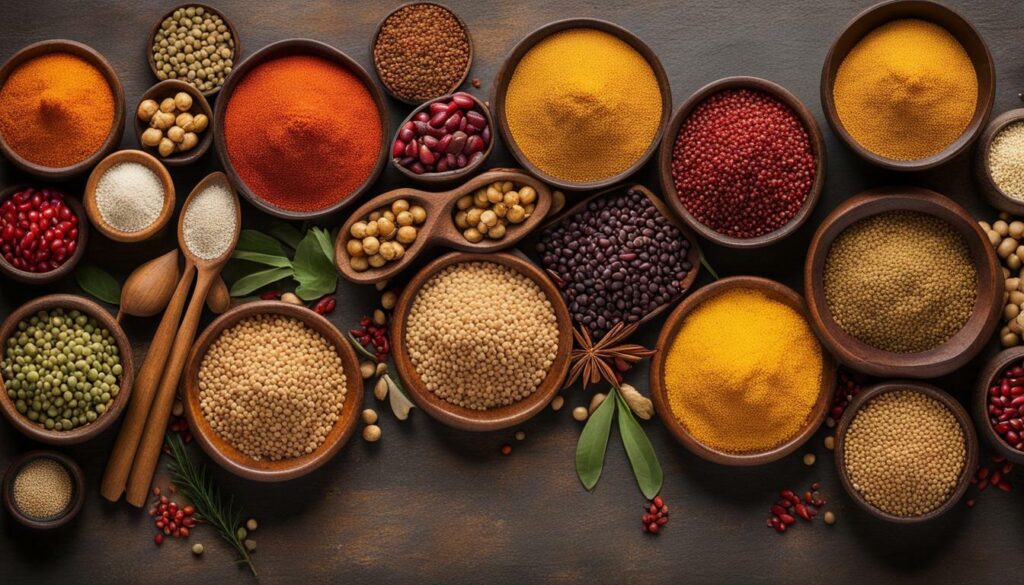
Middle Eastern cuisine offers a plethora of flavorful and beloved dishes that have gained international recognition. These dishes, with their unique blend of spices and ingredients, reflect the rich and diverse culinary traditions of the region. From savoury kebabs to sweet baklava, Middle Eastern cuisine has something to satisfy every palate.
One of the most well-known dishes is hummus, a creamy dip made from mashed chickpeas, tahini, garlic, and lemon juice. It is often enjoyed with pita bread and makes for a delicious and healthy appetizer. Another popular dish is tahini, a versatile sesame seed paste that is used in a variety of Middle Eastern recipes, such as dressings, dips, and sauces.
Falafel, made from ground chickpeas or fava beans, is a favourite vegetarian option. These deep-fried balls or patties are crispy on the outside and tender on the inside and are commonly served in pita bread with a variety of toppings and sauces. Ful mudammas, a traditional Egyptian dish, consists of cooked fava beans seasoned with garlic, lemon juice, and olive oil, and is often enjoyed for breakfast.
Pita bread, a staple in Middle Eastern cuisine, is a versatile and delicious bread that can be eaten with various dishes or used as a wrap for sandwiches. It is typically made with a combination of flour, water, yeast, salt, and olive oil, and is baked at a high temperature to create its signature pocketed shape.
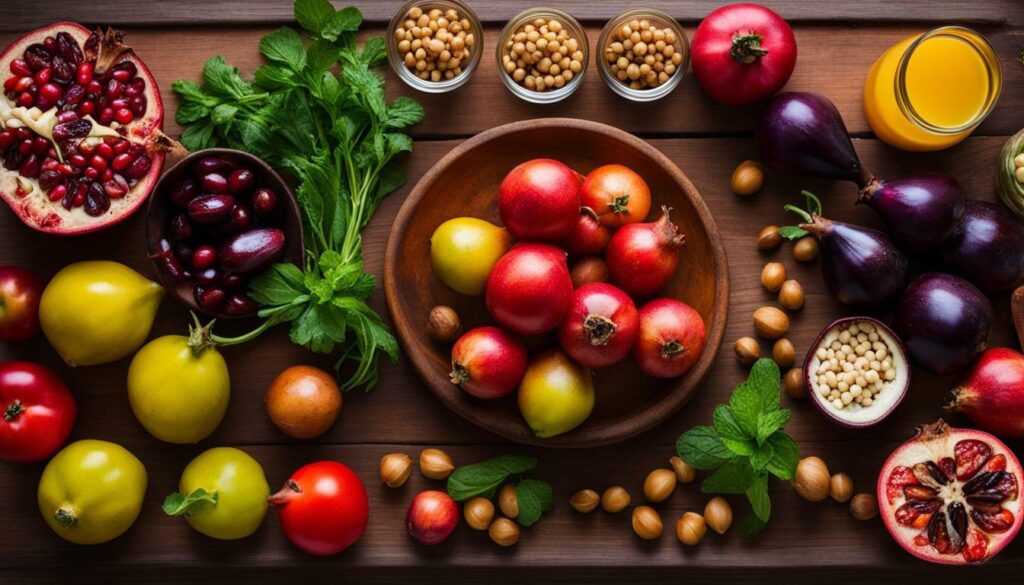
| Dish | Description |
|---|---|
| Baba Ganoush | A smoky eggplant dip made with roasted eggplant, tahini, garlic, lemon juice, and olive oil. |
| Baklava | A sweet pastry made with layers of filo dough, nuts, and honey syrup. |
| Shawarma | Thinly sliced marinated meat, typically beef, lamb, or chicken, served in a pita bread with vegetables and sauces. |
These are just a few examples of the many delicious dishes that make up Middle Eastern cuisine. Whether you’re a fan of savoury meats, vegetarian delights, or sweet treats, there’s something for everyone to enjoy. The flavours and aromas of Middle Eastern cuisine continue to captivate taste buds around the world and showcase the rich cultural heritage of the region.
Local Herbs and Spices in Middle Eastern Cuisine
Middle Eastern cuisine is renowned for its masterful use of local herbs and spices, which infuse dishes with unique and aromatic flavours. The region’s diverse array of indigenous ingredients creates a sensory explosion that delights the palate and captures the essence of Middle Eastern culinary tradition.
One of the most beloved herbs used in Middle Eastern cooking is mint, which adds a refreshing and cool flavour to both savoury and sweet dishes. Whether it’s sprinkled over tabbouleh or steeped in hot tea, mint is a staple herb that gives Middle Eastern cuisine its distinctive taste.
Another key spice in Middle Eastern cooking is cumin, with its warm, earthy flavour. It is an essential ingredient in dishes like hummus, falafel, and lamb kebabs. The aromatic notes of cumin create a harmonious balance with other ingredients, resulting in a depth of flavour that is characteristic of Middle Eastern dishes.
Cardamom, known as the “Queen of Spices,” is another popular spice used in Middle Eastern cuisine. Its sweet and floral aroma adds a hint of elegance to both sweet and savoury dishes. From aromatic rice pilafs to rich desserts like baklava, cardamom is the secret ingredient that elevates Middle Eastern cuisine to new heights.

The use of local herbs and spices in Middle Eastern cuisine not only enhances the taste of dishes but also reflects the cultural heritage and culinary traditions of the region. These flavours have been passed down through generations, shaping the culinary identity of the Middle East and making it a vibrant and diverse gastronomic delight.
| Popular Herbs and Spices in Middle Eastern Cuisine | Flavor Profile | Common Uses |
|---|---|---|
| Mint | Cool, refreshing | Tabbouleh, tea |
| Cumin | Warm, earthy | Hummus, falafel, kebabs |
| Cardamom | Sweet, floral | Rice pilafs, desserts |
With each bite, Middle Eastern cuisine takes you on a journey of flavours, transporting you to the vibrant souks and bustling markets of the region. The use of local herbs and spices is a testament to the rich cultural heritage and culinary traditions that have shaped Middle Eastern cuisine into the culinary treasure it is today.
Meat and Vegetarian Dishes in Middle Eastern Cuisine
Middle Eastern cuisine caters to a wide range of dietary preferences, offering a diverse array of both meat and vegetarian dishes. The region’s culinary tradition embraces the use of various types of meat, including lamb, chicken, and beef, in a multitude of flavorful preparations. Meat dishes such as shawarma, kebabs, and doner kebabs are widely enjoyed for their succulent and aromatic qualities.
On the other hand, Middle Eastern cuisine also offers an abundance of vegetarian options that showcase the region’s culinary creativity. Vegetarian dishes like hummus, falafel, and baba ganoush are rich in flavour and often served with warm pita bread. These dishes typically feature staple ingredients such as chickpeas, tahini, and eggplant, which are combined with aromatic herbs and spices to create delightful and satisfying flavours.
One notable aspect of Middle Eastern vegetarian cuisine is the use of legumes and grains as a protein source. Ful mudammas, a traditional Egyptian dish made from fava beans, is a popular choice. Lentils are also widely used, particularly in hearty soups and stews. The versatility and richness of Middle Eastern vegetarian dishes make them a favourite among both vegetarians and meat-eaters looking to explore new flavours.
Whether one prefers meat or follows a vegetarian diet, Middle Eastern cuisine offers a wealth of delicious options that reflect the region’s culinary tradition and cultural heritage. The combination of bold flavours, aromatic spices, and fresh ingredients contribute to the popularity and appreciation of Middle Eastern food worldwide.
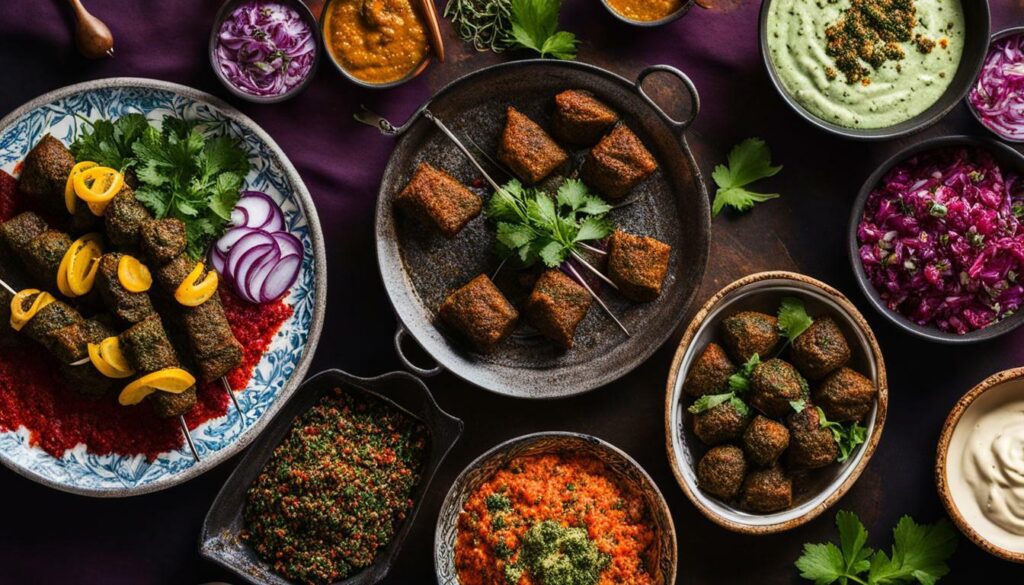
| Meat Dishes | Vegetarian Dishes |
|---|---|
| Shawarma | Hummus |
| Kebabs | Falafel |
| Doner Kebab | Baba Ganoush |
| Mansaf | Moussaka |
| Maklouba | Tabbouleh |
Quote
“Middle Eastern cuisine is a true celebration of flavors, offering a diverse range of both meat and vegetarian dishes that never fail to delight the palate.” – Chef Ahmed, Middle Eastern culinary expert.
Historical Influences on Middle Eastern Cuisine
Middle Eastern cuisine has evolved over time, influenced by an array of historical factors and cultural exchanges. The region’s location, at the crossroads of Europe, Africa, and Asia, has played a significant role in shaping its culinary traditions. From ancient civilizations to invasions and trade routes, Middle Eastern cuisine has absorbed diverse influences, resulting in a rich tapestry of flavours and ingredients.
One of the earliest influences on Middle Eastern cuisine can be traced back to the ancient civilizations that inhabited the region. The Sumerians, Assyrians, and Babylonians cultivated a wide variety of crops, such as wheat, barley, and dates, which formed the foundation of their diets. These ancient culinary traditions laid the groundwork for the flavours and cooking techniques that are still prevalent in the region today.
Throughout history, Middle Eastern cuisine has been shaped by invasions and conquests. The Arab conquests in the 7th century introduced new ingredients such as figs, almonds, and raisins, which were incorporated into local dishes. Later, trade routes with Europe and Asia brought spices like cumin, turmeric, and garlic to the region, adding depth and complexity to Middle Eastern flavours.
The Ottoman Empire, one of the most powerful empires in history, greatly influenced Middle Eastern cuisine. The Ottomans brought with them a love for meat dishes, such as kebabs and shawarma, which became integral parts of the region’s cuisine. They also introduced new cooking techniques, such as slow-roasting and braising, which are still widely used today.

| Historical Influences | Examples |
|---|---|
| Arab Conquests | Introduction of figs, almonds, and raisins |
| Trade Routes | Incorporation of spices like cumin, turmeric, and garlic |
| Ottoman Empire | Introduction of kebabs and slow-cooking techniques |
Today, Middle Eastern cuisine continues to evolve, embracing modern influences while honouring its rich heritage. The use of fresh and locally sourced ingredients remains a cornerstone of Middle Eastern cooking. From the vibrant spices and fragrant aromatics to the hearty stews and delicate pastries, Middle Eastern cuisine has captivated taste buds around the world.
Evolution of Middle Eastern Diets
The evolving diets of the Middle East reflect the region’s history of cultural exchange and the diverse influences it has absorbed. Middle Eastern cuisine history is a testament to the region’s ability to adapt and incorporate new flavours, resulting in a culinary tradition that is as vibrant and varied as the people who call the Middle East home.
Regional Distinctions in Middle Eastern Cuisine
The Middle East is home to a rich tapestry of regional culinary traditions, each with its unique flavours and dishes. From Lebanon’s vibrant mezze platters to Cyprus’ fresh seafood, the Middle Eastern cuisines throughout history have showcased the diverse cultural influences that have shaped the region.
Lebanese cuisine, for example, is known for its fresh and healthy ingredients, including an abundance of vegetables, herbs, and spices. Mezze platters are a staple in Lebanese dining, featuring a variety of small dishes like hummus, tabbouleh, and baba ganoush. The cuisine also showcases an array of grilled meats, such as shish taouk and kafta, seasoned with aromatic spices like sumac and za’atar.
In Egypt, traditional dishes are deeply rooted in ancient history. Molokhia, a soup made from the leaves of the jute plant, is a staple in Egyptian cuisine. Koshari, a comfort food consisting of rice, lentils, and pasta topped with tomato sauce and crispy onions, is another popular dish. Egyptian cuisine also incorporates flavours from neighbouring Mediterranean and African countries, resulting in a harmonious blend of spices and ingredients.
On the island of Cyprus, seafood takes centre stage. The cuisine is heavily influenced by Greek and Turkish cooking styles, resulting in a fusion of flavours. Grilled octopus, fresh fish, and prawns are commonly enjoyed, often accompanied by traditional Cypriot meze, which includes halloumi cheese, olives, and pickled vegetables.
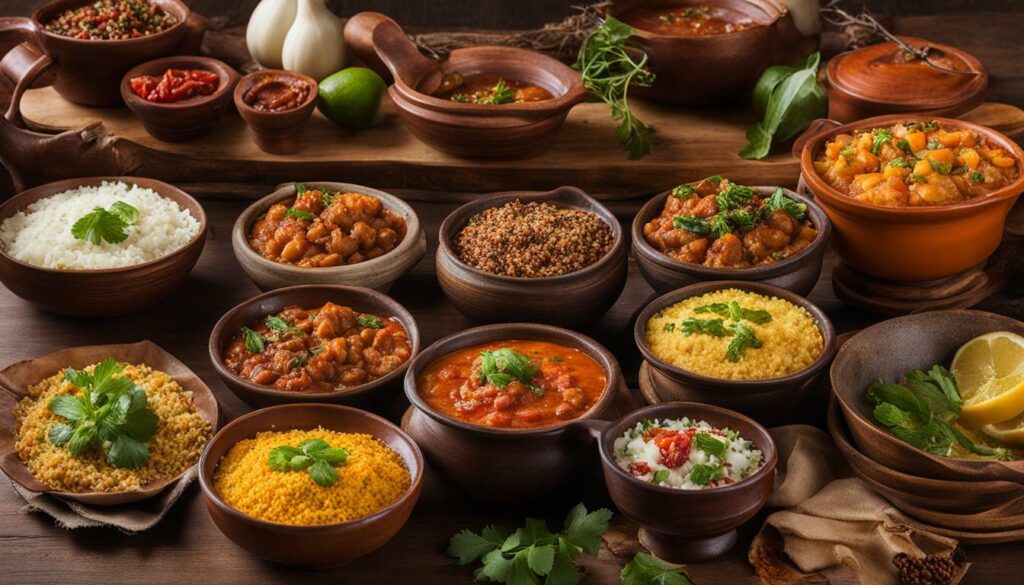
In Kuwait, a desert nation located on the Persian Gulf, the cuisine offers a unique blend of Arabian and Persian influences. Machboos, a spiced rice dish with meat or fish, is considered the national dish. The use of spices like saffron, cardamom, and cinnamon infuse rich flavours into the dishes. Additionally, dairy products such as yoghurt, cheese, and laban (a type of fermented milk) are common in Kuwaiti cuisine.
In Oman, the cuisine reflects the country’s historical maritime connections and Bedouin traditions. Dishes often feature seafood, such as kingfish, tuna, and shrimp, prepared using traditional methods like grilling or marinating in spices. Omani cuisine also includes a variety of rice-based dishes, such as biryani, and dates are a popular ingredient, both in sweet and savoury dishes.
| Country | Regional Cuisine | Key Dishes |
|---|---|---|
| Lebanon | Lebanese | Mezze platters, shish taouk, kafta |
| Egypt | Egyptian | Molokhia, koshari |
| Cyprus | Cypriot | Grilled octopus, halloumi cheese, meze platters |
| Kuwait | Kuwaiti | Machboos, yoghurt-based dishes |
| Oman | Omani | Seafood dishes, biryani, dates-based dishes |
Middle Eastern Cuisine: Global Popularity and Recognition
Middle Eastern cuisine has transcended borders to become a global culinary phenomenon, cherished for its vibrant flavours and cultural significance. With its rich history and diverse influences, Middle Eastern food culture has captivated the taste buds of people around the world.
One of the factors contributing to the popularity of Middle Eastern cuisine is the use of bold and aromatic spices. From the smoky aroma of cumin to the warm earthiness of turmeric, these spices add depth and complexity to dishes, creating a unique and unforgettable dining experience.
Another aspect that has propelled Middle Eastern cuisine onto the global stage is the emphasis on fresh and wholesome ingredients. Herbs like parsley and mint, along with fragrant olive oil and juicy pomegranates, are commonly used to enhance the flavours of various dishes. From hearty stews to light and refreshing salads, Middle Eastern cuisine offers a wide array of options to suit every palate.
Furthermore, the rise of vegetarian and plant-based diets has also contributed to the popularity of Middle Eastern cuisine. The cuisine’s emphasis on legumes, grains, and vegetables makes it inherently vegetarian-friendly, offering flavorful and satisfying options for those seeking a more plant-based lifestyle.
As Middle Eastern cuisine continues to gain recognition, it has inspired chefs and home cooks alike to explore its rich traditions and incorporate them into their own culinary creations. The fusion of Middle Eastern flavours with modern cooking techniques has resulted in innovative and exciting dishes that are enjoyed by people of all backgrounds.
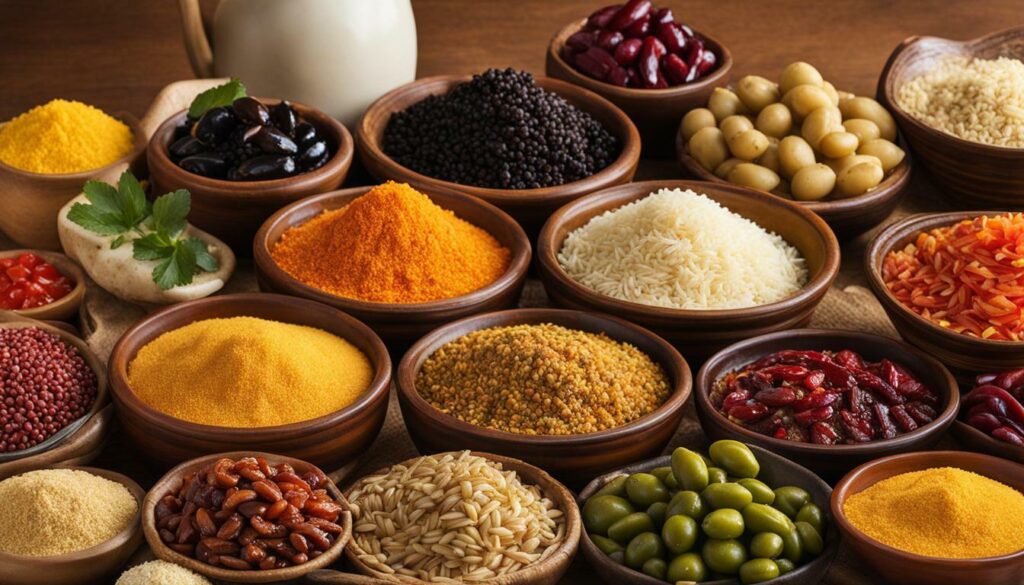
In conclusion, Middle Eastern cuisine has become a global sensation, celebrated for its vibrant flavours, cultural heritage, and the sense of community it embodies. Whether you are savouring a warm bowl of hummus or indulging in a sweet and flaky baklava, each bite offers a glimpse into the rich culinary tapestry of the Middle East.
Conclusion
The past and present diets of the Middle East stand as a testament to the rich culinary heritage and cultural diversity of the region. Exploring the history of food in the Middle East reveals a cuisine that has been shaped by a variety of factors, including the Mediterranean climate, ancient religions, and cultural exchanges with Europe, Africa, and Asia.
Staple ingredients such as olives, honey, sesame seeds, mint, chickpeas, and parsley are used across Middle Eastern cuisines, providing a foundation for a wide range of dishes. Some of the most popular creations include kebabs, baklava, dolma, yoghurt, doner kebab, and shawarma, each offering a unique blend of flavours and textures.
The use of local herbs and spices, such as nutmeg, caraway, cumin, turmeric, parsley, and mint, adds depth and complexity to Middle Eastern cuisine. Whether in meat-based dishes or vegetarian options, Middle Eastern food culture embraces a diverse range of flavours and ingredients, with lamb, chicken, beef, and a variety of vegetables taking centre stage.
Throughout history, Middle Eastern cuisine has been influenced by various invaders and traders. The introduction of ingredients like figs, nuts, and dates, as well as the incorporation of spices from the Far East, have left a lasting impact on the region’s culinary traditions. Furthermore, the distinct cuisines of Lebanon, Egypt, Oman, Kuwait, Iraq, Iran, Bahrain, and Cyprus contribute to the rich tapestry of Middle Eastern food culture.
In recent years, Middle Eastern cuisine has gained global popularity and recognition. Dishes such as hummus, tahini, falafel, ful mudammas, pita bread, baba ganoush, and baklava have become household names in many parts of the world. With its diverse flavours, vibrant colours, and rich history, Middle Eastern cuisine continues to captivate taste buds and inspire culinary innovation.
FAQ
What are some staple ingredients in Middle Eastern cuisine?
Staple ingredients in Middle Eastern cuisine include olives, honey, sesame seeds, mint, chickpeas, and parsley.
What are some popular dishes in Middle Eastern cuisine?
Some popular dishes in Middle Eastern cuisine include kebabs, baklava, dolma, yoghurt, doner kebab, and shawarma.
What herbs and spices are commonly used in Middle Eastern cuisine?
Local herbs and spices commonly used in Middle Eastern cuisine include nutmeg, caraway, cumin, turmeric, parsley, and mint.
Are there meat and vegetarian options in Middle Eastern cuisine?
Yes, Middle Eastern cuisine offers both meat and vegetarian options. Lamb, chicken, and beef are commonly used in meat dishes, while a wide variety of vegetarian options are also available.
How has Middle Eastern cuisine been influenced by history?
Middle Eastern cuisine has been influenced by historical factors such as the introduction of ingredients like figs, nuts, and dates by invaders, and the incorporation of spices such as cumin, turmeric, and garlic from the Far East.
Are there regional culinary traditions within Middle Eastern cuisine?
Yes, the Middle East has various regional culinary traditions, including the distinct cuisines of Lebanon, Egypt, Oman, Kuwait, Iraq, Iran, Bahrain, and Cyprus.
Is Middle Eastern cuisine popular globally?
Yes, Middle Eastern cuisine has gained global popularity and recognition in recent years, influencing modern-day cuisines and food culture.
Source Links
- https://gourmandelle.com/middle-eastern-cuisine/
- https://www.bl.uk/learning/timeline/item109155.html
- https://brill.com/edcollbook/title/55624?language=en
Read Our Articles On The Other Regions of Asia Here:
| Past and Present Diets of South Asia |
| Past and Present Diets of Southeast Asia |
| Past and Present Diets of East Asia |
| Past and Present Diets of Central Asia |
| Past and Present Diets of the Indian Subcontinent |



